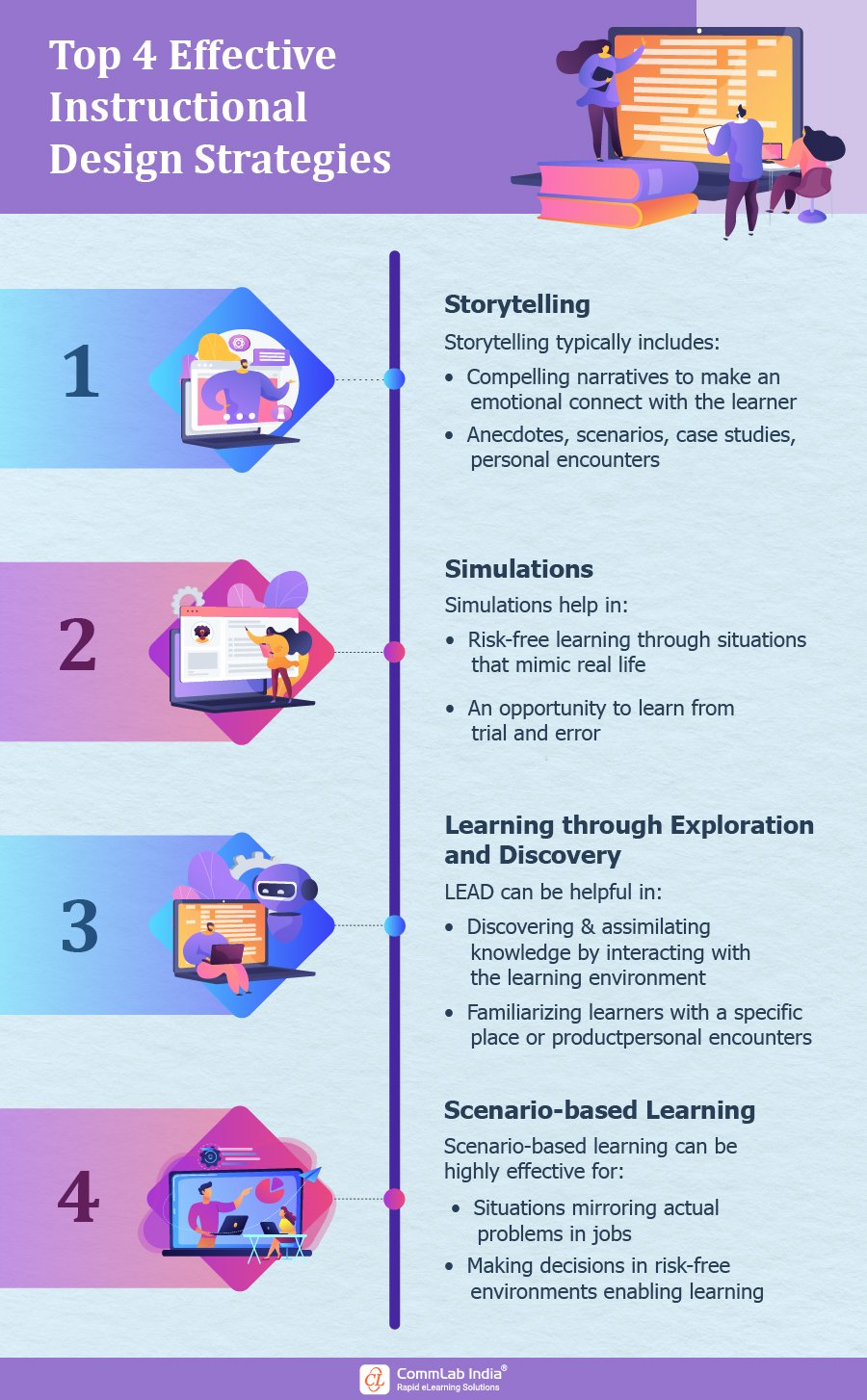Top 4 Instructional Design Techniques for eLearning Courses

Because the goal of rapid eLearning is to create courses rapidly, it does not need to sacrifice instructional design. We have some unique new-age instructional approaches to assist you in building captivating eLearning courses with the help of rapid eLearning. Robust instructional design is at the core of any effective eLearning course. Instructional design solutions are available to provide learner engagement with the much-needed boost, with learner engagement being among the top difficulties L&D professionals encounter.
What Are the Instructional Design Strategies for an Engaging eLearning Experience?
Here are the top 4 Instructional design strategies to ensure a memorable learning experience:
- Storytelling
- Simulations
- Learning Through Exploration and Discovery (LEAD)
- Scenarios
With so many instructional design methodologies to choose from, it’s important to do your homework. The correct instructional design technique acts like a magic wand to get learners to participate in the learning process. Let’s explore 4 innovative instructional design strategies for your eLearning courses in this blog.
>Top 4 Effective Instructional Design Strategies
1. Storytelling
Storytelling is an extremely popular instructional design method, which comes as no surprise. Stories keep us captivated and emotionally attached because they’re always personal.
Storytelling not only engages learners in order to improve learning and perform much better, but it aids them in achieving their learning objectives. It also improves retention. Storytelling typically includes:
- Compelling narratives to make an emotional connect with the learner
- Anecdotes, scenarios, case studies, personal encounters
Discover How ID Strategies Assist in Sticky Learning Experiences.
2. Simulations
Simulations simulate circumstances in a virtual environment, giving learners a setting comparable to their work experience. Learners may obtain practical learning experiences in a threat-free setting with this high-level learning technique. Simulation is used for most of the software training.
Watch, Try, and Do are the 3 steps in which authoring tools assist in the development of simulations:
- Learners are instructed how to perform various activities in software via instruction callouts during the ‘Watch’ phase.
- Learners do the steps on their own in the ‘Try’ phase, with help of hints and prompts.
- Learners accomplish the steps without any assistance during the ‘Do’ phase.
Simulations help in:
- Risk-free learning through situations that mimic real life
- An opportunity to learn from trial and error
3. Learning Through Exploration and Discovery (LEAD)
Unlike other instructional design methodologies that encourage learners to passively absorb information, LEAD (Learning Through Exploration or Discovery) encourages learners to actively participate all throughout the learning process. Learners are given the flexibility of ‘exploring’ and acquiring knowledge by investigating and engaging with learning materials in a virtual context in LEAD, which is also referred to as inquiry-based learning. LEAD can be helpful in:
- Discovering & assimilating knowledge by interacting with the learning environment
- Familiarizing learners with a specific place or product
4. Scenarios
Scenario-based learning places learners in scenarios in which they must complete tasks or decide based on what they have learned. It gives learners obstacles that are comparable to those they would experience in real life. Scenario-based learning aids in the development of critical-thinking abilities and the application of knowledge obtained on the job. Scenario-Based learning can be highly effective for:
- Situations mirroring actual problems in jobs
- Making decisions in risk-free environments enabling learning
Parting Thoughts!
These instructional design tactics not only create memorable learning experiences for your learners, but they also keep them interested and fulfilled. After all, every company wants to ensure learner engagement for efficient on-the-job implementation. As a result, to meet modern-day learning demands, assure compelling online training using instructional design tactics that are current, compelling, immersive, and, most importantly, modern.
While we spoke about how to use instructional design principles to build memorable eLearning experiences, wouldn’t you want to know how to get these courses up and running quickly? Here’s a free eBook you shouldn’t miss! “Rapid eLearning Design for Quick Rollout.”
Editor’s note: This post was originally published in June 2022 and has been updated for comprehensiveness.




![Authoring Tools – The Secret Behind Rapid eLearning Solutions [Infographic]](https://blog.commlabindia.com/hubfs/Imported_Blog_Media/authoring-tools-rapid-elearning-solutions-infographic-v2.png)
![Gear Up for 2023! eLearning Trends for the Year [Webinar]](https://blog.commlabindia.com/hubfs/Imported_Blog_Media/elearning-trends-2023-a-view-from-the-trenches-webinar.png)
![Classroom Training VS. Online Training [Infographic]](https://blog.commlabindia.com/hubfs/Imported_Blog_Media/classroom-training-elearning-mlearning-1.jpg)